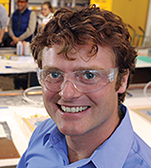Center for Instructional
Innovation and Assessment
INNOVATIVE TEACHING SHOWCASE
2013
2014
Institutional Goals
Listed below are selected learning outcomes in the areas of critical thinking, writing, and information literacy that Western Washington University is actively integrating into its curriculum. Each learning outcome is listed with its definition, along with a description of how Jerimiah Welch's teaching strategies meet each of these student learning outcome goals.Critical Thinking
| Learning Outcomes | Definition | Course Outcomes |
|---|---|---|
| Identification | Accurately identifies and interprets evidence. | Students will be able to read and interpret engineering drawings and symbols. Students will be able to evaluate how different types of fit and tolerances in the real world correspond to fits and tolerances in the virtual world. |
| Alternative Consideration | Considers major alternative points of view. | Students will be able to select the best technique to apply to creating a given part in a CAD system. Students will be able to choose the best dimensioning scheme to communicate their design intent in a drawing. |
| Accurate Conclusions | Draws warranted, judicious, non-fallacious conclusions. | Students will be able to visualize 3d objects from 2d drawings. Students will be able to create 2d drawings and 3d objects from their own ideas. |
| Justification | Justifies key results and procedures, and explains assumptions and reasons. | Students will be able to justify and explain the dimensions and tolerances that they choose when designing a part or assembly. |
Writing
| Learning Outcomes | Definition | Course Outcomes |
|---|---|---|
| Rhetorical Knowledge | Focuses on a clear rhetorical purpose and responds appropriately to the needs of varied audiences and situations. | Students will be able to choose the best way to visually and verbally communicate design intent to other engineers, businesspeople, and manufacturers. |
| Critical Analysis | Develops, examines, situates, and communicates a reasoned perspective clearly to others. | Students will be able to choose the best drawing views, part dimensions, tolerances, and annotations to communicate their design intent to both inspection and manufacturing audiences. |
| Composing Processes | Understands writing as a recursive process that involves drafting, re-thinking, editing, re-conceptualizing. | Students will have firsthand experience with the iterative nature of the design process, and be able to model parts and drawings that can adapt gracefully to future revisions. |
| Convention Knowledge | Uses appropriate conventions for documentation and for surface features such as syntax, grammar, usage, punctuation, and spelling. | Students will be able to use appropriate engineering terminology when creating drawings and discussing parts and assemblies. |
Adapted from Western Washington University's Learning Outcomes for Writing II.
Information Literacy
| Learning Outcomes | Definition | Course Outcomes |
|---|---|---|
| Identifying Need | Recognizes and articulates the need for information, identifies potential sources, considers the costs and benefits, and reevaluates the nature and extent of the information need. | Students will develop a base of reference materials for later on in their careers as well as search strategies to overcome 3d modeling and drawing communication obstacles and challenges. |
| Search Strategies | Matches information needs to information resources, organizes an effective search strategy and manages the information and its sources. | Students will develop a base of reference materials for later on in their careers as well as search strategies to overcome 3d modeling and drawing communication obstacles and challenges. |
| Evaluating | Evaluates information and its sources critically and incorporates selected information into his or her knowledge base and value system. | Students will be able to compare newly discovered knowledge to existing best practices for sketching, modeling, assembling, and drafting learned during the course. |
| Synthesis | Applies new and prior information to the planning, creation, and revision of the development process, and communicates the product or performance effectively. | Students will be able to use SCRUM methodology to create and modify product plans in response to both product scope expansion and the group’s actual (vs. estimated) progress. |
| Responsibility | Understands many of the economic, legal, and social issues surrounding the use of information and accesses and uses information ethically and legally. | Students will understand the role of 2d drawings and 3d modeling files in manufacturing contracts and relationships. |
Adapted from Western Washington University's Learning Outcomes for Writing II.
Quantitative Reasoning
| Learning Outcomes | Definition | Course Outcomes |
|---|---|---|
| Mathematical Information | Represent mathematical information symbolically, visually, numerically, and verbally. | Students will be able to use parametric modeling to create design intent in 3d parts and assemblies. |
| Mathematical Methods | Use arithmetical, algebraic, geometric, and statistical methods to solve problems. | Students will be able to create dynamic 3d relationships using modeling formulas. Students will be able to use design parameters to influence the volume, surface area, and weight of a part. |
| Mathematical Models | Interpret mathematical models such as formulas, graphs, tables, and schematics, and draw inferences from them. | Students will be able to read design tables and apply the knowledge to create parts that reflect the table’s design intent. |
| Estimate and Check | Estimate and check answers to mathematical problems in order to determine reasonableness, identify alternatives, and select optimal results. | Students will be able to hypothesize dimensions and tolerances for first run parts. They will be able to prototype parts using 3d printing. Finally, they will be able to empirically verify or modify the dimension for the next iteration of the part. |
| Mathematical and Statistical Limits | Recognize that mathematical and statistical methods have limits. | Students will be able to understand the manufacturing limits reflected in standard tolerances as well as in Geometric Dimensioning and Tolerancing. |
Source:
Adapted from Western Washington University's Learning Outcomes for Writing II.



